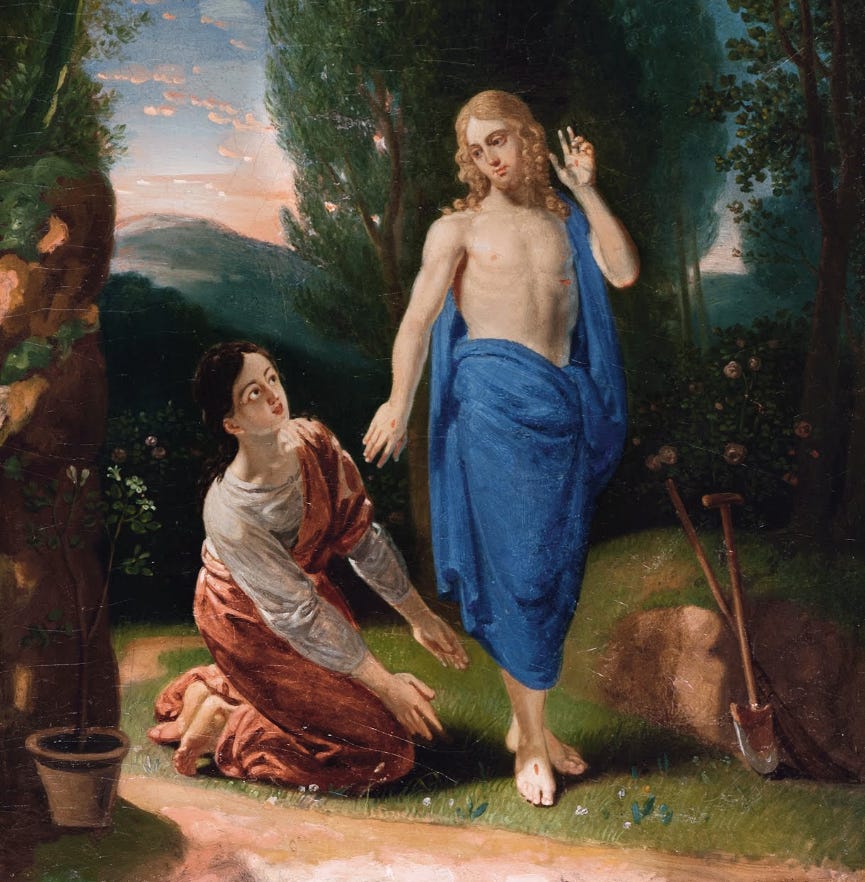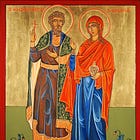
One of my favorite parts of the text we read every Easter is the encounter between Mary Magdalene and Jesus.
Mary and the disciples have just realized in a panic that the stone has been removed from the tomb and that Jesus’ body is gone (John has also just dropped a humble brag about how fast he can run – one of my favorite lines, reminding me that the Bible was, in fact, written by humans).
After all of this has happened, Mary is sitting alone by the tomb. She meets two angels, then Jesus himself, who she mistakes as the gardener. In this scene, Mary is the first to encounter the risen Christ.
She is trusted by God to bring the story of the resurrection back to the disciples, introducing the foundational miracle of the Christian faith to the rest of the world.
This is a huge deal.
At this time, Mary couldn’t be called as a witness in a court of law. But the God of the universe entrusted Mary Magdalene – her hands, her feet, her voice – with the story of the miracle of the resurrection.
(So in case you’re wondering if women should be allowed to preach, God thinks they can.)
If we look at Mary Magdalene, we can uncover a woman of influence and power, a close confidant of Jesus and a co-conspirator in the project of God. We don’t know a ton about her, but we do know a few things:
She was from Magdala, a town on the Sea of Galilee known for its fishing ports. She was a close friend of Jesus, mentioned thirteen times by name over the course of the New Testament. She may have even been independently wealthy – when we are introduced to her for the first time in Luke 8, she is included in a group of women who have “provided for [the disciples] out of their own means.” This patron relationship would have come with a level of influence.
Mary Magdalene is an enormously important figure in the story of Jesus. However, over time, her story has been stifled, her influence trivialized and de-legitimized.
And from the perspective of power, it makes sense.
If women hear the story of Mary Magdalene – beloved by God, trusted by God – what might they begin to believe about themselves?
Which brings us to a fact we *think* we know about Mary Magdalene.
Mary Magdalene as a sex worker.
…Despite the *checks notes* zero times Mary Magdalene is connected to sex work in the Bible.
This idea originated hundreds of years later in a homily by Pope Gregory I in the 6th century. In this sermon, he fuses her with the unnamed “sinful woman” with the alabaster jar who anoints Jesus’ feet with oil in an intimate, sacred ceremony in Luke 7:36-50. He also pulls from this line in Luke, where we first meet Mary Magdalene:
“Mary, called Magdalene, from whom seven demons had gone out.”
Pope Gregory interprets the seven demons as the seven deadly sins (also a creation of the Catholic Church, not the Bible), highlighting lust, which he considers to be “a particularly feminine vice.”1
“The one that Luke calls a sinner, and that John names Mary, we believe that she is that Mary of whom, according to Mark, the Lord has cast out seven demons. And what are these seven demons, if not the universality of all vices?… It is very evident, my brethren, that this woman, formerly addicted to forbidden deeds, had used perfume to give her flesh a pleasant odor. What she had shamefully granted to herself, she now offered to God in a manner worthy of praise.”
tl;dr Pope Gregory I got really creative, using three different unrelated texts to write Mary Magdalene fanfiction, casting her as a sex worker.
This theory stuck, expanding into more and more fantastical Mary Magdalene lore over time. In the Middle Ages, Voragine’s The Golden Legend describes her this way:
“Very rich, and sensuous pleasure keeps company with great wealth. Renowned as she was for her beauty and her riches, she was no less known for the way she gave her body to pleasure—so much so that her proper name was forgotten and she was commonly called ‘the sinner.’”2
The important question isn’t “Was Mary Magdalene a sex worker or not?” (Answer: No). The important question is, “Why would that matter?”
Even if she were a sex worker (she wasn’t), why would that prevent her from also being one of Jesus’ most trusted friends and confidants? Why do we think that would tell us anything about her intelligence, her influence, her power?
Why did Pope Gregory I, and generations of powerful men after him, try so hard to connect Mary Magdalene with sex work? As their logic goes, if she was a sex worker, then surely she wasn’t that important in Jesus’ ministry.
Since the scapegoating of Eve, the embodied, sensual, creative feminine power has been framed as something sinful, sinister, untrustworthy.
But that’s not what Jesus thought.
Despite Pope Gregory I’s revisionist history. Despite centuries-old attempts to delegitimize her. Despite the cultural determination to make women’s bodies sinful and narratives untrustworthy, Jesus walked with her, called her by name, and chose her as the first witness to the resurrection.
Mary Magdalene, in all her powerful femininity, beloved by God.
Mary Magdalene, in all her powerful femininity, one of Jesus’ most trusted friends.
Mary Magdalene, in all her powerful femininity, trusted by the risen Christ to carry and birth to the story of new life.
Alleluia.
Thin Space Cowboy is a reader-supported publication written and created by Lindsey Kelley. Click here to subscribe or gift a friend a subscription here (if a friend sent you this email—tell them thank you!). Have questions? Requests? Reply to this email to reach me directly!
Monzón Pertejo, Elena, and Victoria Bernad López. 2022. "The Demons of Judas and Mary Magdalene in Medieval Art" Religions 13, no. 11: 1048. https://doi.org/10.3390/rel13111048 (pg 14)
Voragine, Jacobus de. 2012. The Golden Legend. Readings on the Saints. Princeton: Princeton University Press.









YES YES YES!!!